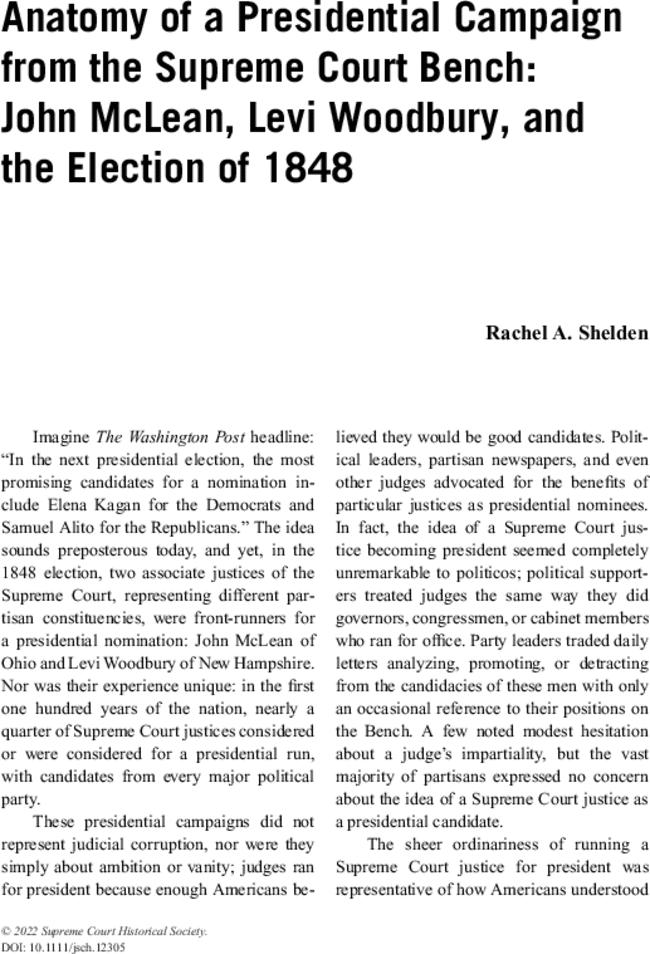Anatomy of a Presidential Campaign from the Supreme Court Bench: John McLean, Levi Woodbury, and the Election of 1848
IF 0.2
Q3 HISTORY
引用次数: 0
Abstract
Imagine The Washington Post headline: “In the next presidential election, the most promising candidates for a nomination in clude Elena Kagan for the Democrats and Samuel Alito for the Republicans.” The idea sounds preposterous today, and yet, in the 1848 election, two associate justices of the Supreme Court, representing different par tisan constituencies, were front-runners for a presidential nomination: John McLean of Ohio and Levi Woodbury of New Hampshire. Nor was their experience unique: in the first one hundred years of the nation, nearly a quarter of Supreme Court justices considered or were considered for a presidential run, with candidates from every major political party. These presidential campaigns did not represent judicial corruption, nor were they simply about ambition or vanity; judges ran for president because enough Americans be lieved they would be good candidates. Polit ical leaders, partisan newspapers, and even other judges advocated for the benefits of particular justices as presidential nominees. In fact, the idea of a Supreme Court jus tice becoming president seemed completely unremarkable to politicos; political support ers treated judges the same way they did governors, congressmen, or cabinet members who ran for office. Party leaders traded daily letters analyzing, promoting, or detracting from the candidacies of these men with only an occasional reference to their positions on the Bench. A few noted modest hesitation about a judge’s impartiality, but the vast majority of partisans expressed no concern about the idea of a Supreme Court justice as a presidential candidate. The sheer ordinariness of running a Supreme Court justice for president was representative of how Americans understood

从最高法院法官席剖析总统竞选:约翰·麦克莱恩、莱维·伍德伯里和1848年大选
想象一下《华盛顿邮报》的标题:“在下届总统选举中,最有希望获得提名的候选人——包括民主党的埃琳娜·卡根和共和党的塞缪尔·阿利托。”这个想法在今天听起来很荒谬,然而,在1848年的选举中,代表不同党派选区的两名最高法院大法官是总统提名的领跑者:俄亥俄州的约翰·麦克莱恩和新罕布什尔州的利瓦伊·伍德伯里。他们的经历也不是独一无二的:在美国建国的头一百年里,有近四分之一的最高法院大法官考虑或被考虑参加总统竞选,候选人来自每个主要政党。这些总统竞选并不代表司法腐败,也不只是野心或虚荣;法官竞选总统是因为有足够多的美国人相信他们会是很好的候选人。政治领袖、党派报纸,甚至其他法官都主张某些法官作为总统提名人的好处。事实上,对政治家来说,最高法院法官成为总统的想法似乎完全不引人注目;政治支持者对待法官就像对待州长、国会议员或竞选公职的内阁成员一样。党的领导人每天都在信件中分析、支持或贬低这些人的候选人资格,只是偶尔提到他们在法官席上的职位。少数人对法官的公正性表示了适度的犹豫,但绝大多数支持者对最高法院大法官成为总统候选人的想法并不担心。让最高法院的法官担任总统的纯粹平凡,代表了美国人的理解
本文章由计算机程序翻译,如有差异,请以英文原文为准。
求助全文
约1分钟内获得全文
求助全文

 求助内容:
求助内容: 应助结果提醒方式:
应助结果提醒方式:


